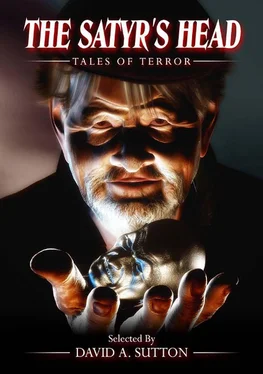Suddenly, faint in the distance, I heard the muffled sound of a piano playing. It was not a radio, not a recording, but unmistakably an echo from the drafty rotunda downstairs where reposed the fragile, ornate instrument once reputedly owned by Liszt.
I walked downstairs as if in a dream, hardly aware of what I was doing. I knew the piece: it was Liszt’s Campanella ; someone played it in a Hitchcock movie once, and it had stuck in my mind: fragile, elfin bells in a silver tintinnabulation of sound. As I entered the lofty rotunda the piano, deep in shadow, loomed across the room, stark Spanish cannon silhouetted incongruously against it as still deeper shadows.
My eyes adjusted to the gloom and began to half-discern what appeared to be a dark, swaying, undefined shape hovering above the keyboard, moving in the circumscribed patterns a rapt player might follow. The music still had a distant, stifled quality, and I wondered if the ancient hammers and pedals were really moving: surely the instrument would not be in tune after so many years. But what had Ehlers written? "Objects… associated with passionate people and events soak up and retain an aura, and may produce a tangible emanation, even sensory stimuli…"
Suddenly the racket of the Nightingale Floors erupted around me again, louder than ever before, deafening, from all over the house, so that the spell holding me broke and I felt terror, bewilderment; and turned to run, to flee this strange museum with its entombed but living sampling of the past.
But the only way out lay through the unlit Remington gallery, that tomb-black trap I had always distrusted. And I had left both flashlight and weapons upstairs!
There was no other choice, and as I blundered into the room of Wild West art I sensed that it was neither entirely dark nor entirely untenanted.
Outlined in a light that was not light, since it did not diffuse, I saw the erect, majestic form of an Indian chief in full ceremonial regalia: feathered headdress, buckskin leggings, beaded belt, with a crude bow slung across one bare, muscular shoulder. (Could an artist’s intensification of reality also entrap an image from the past, even though the painting itself had never been in the physical presence of its subject?)
The figure of the Indian moved lithely toward the centre of the chamber, but I was past it already, bounding through the archway opposite as if propelled by the crackling of the floors, now intensified to such a degree that it resembled a fireworks display.
I staggered into the next gallery, but stopped short to locate and avoid any further unnatural phenomena there.
This was one of the medieval rooms, and at first it seemed there was nothing unusual here except the frantic snapping of the flooring. Then my glance fell on an Elizabethan headsman’s axe mounted on the wall, faintly illuminated by one of the dim night lights several yards distant.
Before my eyes, a wavering form shaped itself around the axe, stabilized, and came clear, lifelike: the black-hooded, swarthy figure of the executioner, both brawny fists grasping the haft of the immense, double-headed weapon, which hung at an angle as if to accommodate itself to the natural grip of the burly beadsman.
I wheeled in panic and sprinted for the front door, threw back the night latch, and half-stumbled down the stairs and across the mangy lawn under the spectral benches of the great poplars, whose dry leaves rattled and chattered as if in derisive echo of the tumultuous uproar of the floorboards in the empty building behind me.
I phoned in my resignation to Mr. Worthington next day (since, superstitious as my attitude might seem, I never wished to enter the Ehlers Museum again) and started the long comeback path to a normality in which I could at least distinguish between the real and the illusory. Which is about all any of us can claim, at best.
For I had seen something during those last few seconds in the museum that frightened me more than anything else I experienced that night.
I have said that the apparition of a giant executioner gripping his axe had appeared in the medieval gallery. Well, the axe was mounted on the wall just above another quaint relic of those earlier days when our savagery was less subtle: the rough-hewn wooden headsman’s block.
And as the figure of the executioner coalesced around his axe, so another figure — supine, hands bound, neck wedged in the gruesomely functional V-shaped depression — materialized around the block.
The face was turned toward me, and I recognized from photos the florid, mutton-chopped visage of Frederick Ehlers, long-dead founder of the museum, staring in terror — still caught in his endless chain of nightmares, still a prisoner (but now a part) of those "tangible emanations" from the past which he had painstakingly assembled and which he had finally and forever, inescapably joined.
THE PREVIOUS TENANT
by Ramsey Campbell
HE CLOSED THE CUPBOARD door and crossed to the window. The pane exhibited ghostly strokes of soap, like the paint sketched on the sheet of paper he’d crumpled up last week. In the next room his wife moved a table, which screamed. He stared out. The roofs were a jagged frieze against the colours spilled to mix on the horizon; below, the red streetlamps tasted of raspberry, tinting the trees like attenuated pine-cones separated by the ruler of the pavement. A car passed, hushed as the evening, casting ahead on the road what seemed already a splash of yellow paint. It wasn’t enough for him to express on canvas. He turned back to the flat room, the wallpaper’s pastel leaves whose meaning had been lost through countless prints, the bed he must never touch without having bathed. He had remembered what he’d seen as the cupboard door had closed.
The imprisoned books rebuked him; already, on the Renoir, a coil of dust curled and fidgeted like a centipede. What he’d seen was crushed beneath Matisse and Toulouse-Lautrec; he hoisted them and slid it out. It was a photograph of the girl who had owned the flat: one leg high on a wall, her skirt taut, her hand arched on her knee, her eyes beneath an arch of lustrous hair smiling at whoever held the camera; how could she have become a scream above the city, a broken figurine beneath the window? His wife coughed. At once he thrust the photograph into his pocket. At the door he turned to check the cupboard. It was closed.
His wife was cross-legged on the carpet, surrounded by the glasses from the cabinet, considering the space available. ‘I’ve done the best I can,’ he said.
She dabbed a bead of lacquer from her forehead. ‘It’s not your books I object to, you know that,’ she told him… it’s just that there’s not enough space, that’s all.’
‘I don’t remember you complaining when we looked it over.’
‘Who’d complain at a flatful of furniture?’ Above her stood the antique chairs, the glass-topped tables, the mirrors with which the girl had surrounded herself. ‘But there’s such a thing as being over-generous, you know.’
He was silent; he didn’t want to say ‘we should be grateful.’
‘If we get rid of a few of these things you could have your painting on the wall.’
‘There’s no point.’ Not in one painting and a hundred crumpled scraps of drawing-paper.
‘It might brighten the place up a little.’
‘That’s a profound analysis,’ He watched her stretch her legs, hemmed in by the glasses; it seemed a perfect symbol — he would have transferred it to canvas if he had been able to paint her.
‘I know I don’t have your intellect.’ She picked up a glass; in a club she wouldn’t long have held it empty.
‘I’ve never said so, have I? What you don’t have is sensitivity to this flat. It’s the girl’s life. There’s the chair where she must have sat when she composed the note. Or is that what’s bothering you?’
Читать дальше












